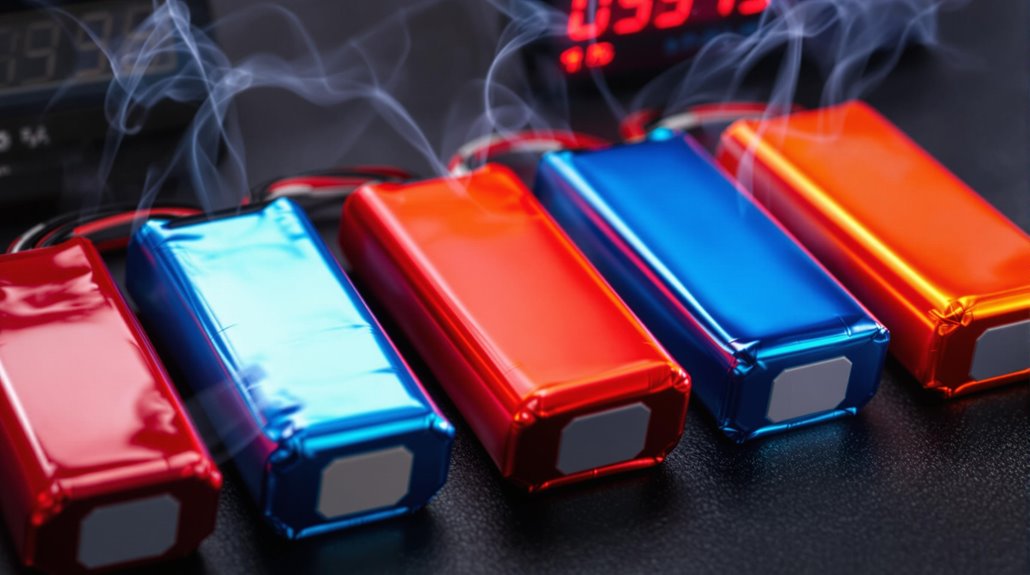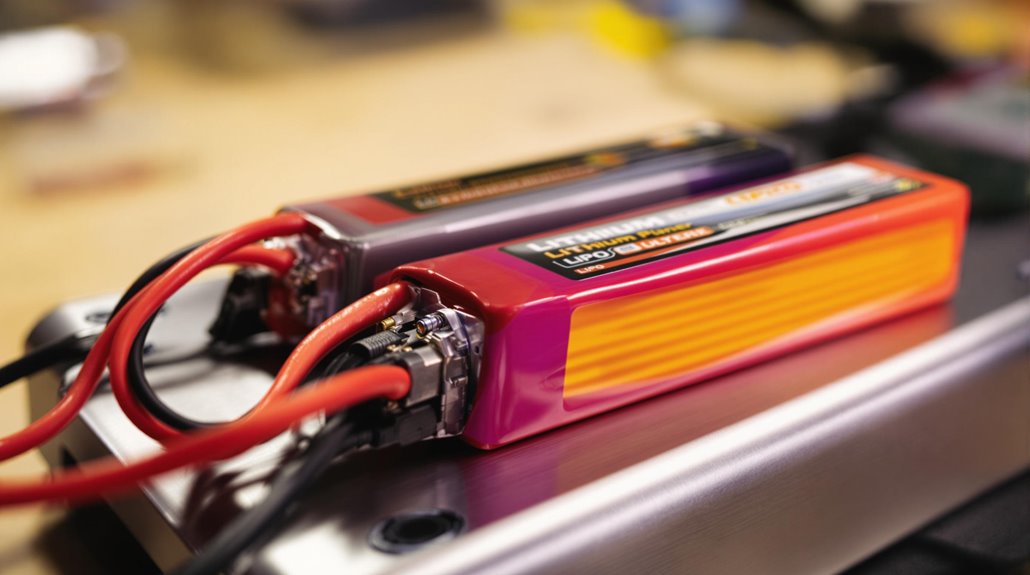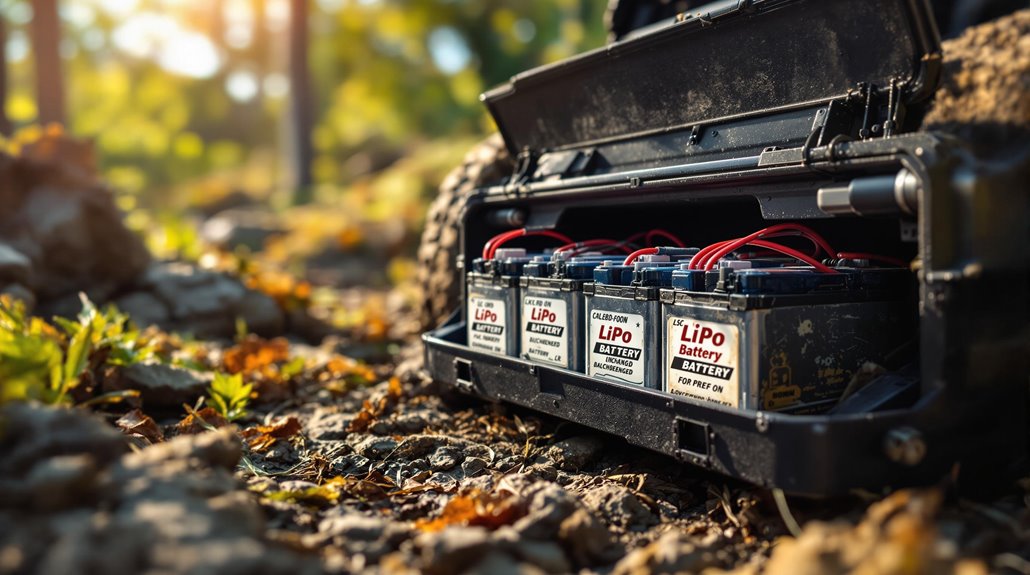Lithium Polymer (LiPo) Batteries for RC Vehicles Need to Be Discharged Properly

Discharging your Lithium Polymer (LiPo) batteries for RC vehicles properly is crucial for their health and performance. Always keep the voltage above 3.0V per cell to avoid damage, ideally discharging to 3.3–3.5V for regular use. Using a battery discharger or a LiPo charger with a discharge function can help manage voltage levels effectively.
Employing low voltage cutoff settings and battery alarms can prevent over-discharging. Neglecting these practices could lead to risks like swelling or fire. To enhance your understanding of safe usage, you'll uncover more tips and tricks that can help you maximize your battery's lifespan.
Key Takeaways
- Discharge LiPo batteries to 3.3–3.5V per cell for optimal performance and extended lifespan.
- Avoid discharging below 3.0V to prevent damage and safety hazards.
- Use a battery discharger or LiPo charger with discharge functions for controlled voltage levels.
- Implement battery voltage alarms to alert when nearing critical discharge levels.
- Regularly monitor battery voltage with a multimeter to maintain cell balance and integrity.
When to Discharge LiPo Batteries
Discharging your LiPo batteries at the right time is crucial for their longevity and performance. You should aim to discharge your LiPo cells to a minimum voltage of 3.0V per cell to avoid damaging them. Ideally, during regular use, keep the discharge voltage in the range of 3.3–3.5V per cell. This practice not only enhances battery health but also helps prevent issues like swelling or leakage.
For long-term storage, it's smart to discharge your batteries to about 3.7–3.8V per cell. This maintains their health and ensures they last longer. Remember, fully discharging LiPo batteries is essential before disposal to mitigate fire risks and ensure safety.
Additionally, be sure to balance your cells by discharging them to the same voltage. This step guarantees consistent performance and longevity of your battery pack. Regular discharge and charge cycles play a vital role in maintaining battery health, so don't overlook this aspect of your battery management routine. By following these guidelines, you'll keep your LiPo batteries performing at their best.
Importance of Proper Discharge
Properly discharging your LiPo batteries is vital for maintaining their safety and performance. If you neglect proper discharge practices, you could face serious safety hazards, including swelling, leakage, or even fire. To ensure your LiPo battery remains in optimal condition, keep these key points in mind:
- Voltage Levels: Always maintain a voltage above 3.0V per cell during discharge. Going below this threshold can cause irreversible damage to the battery's cells.
- Recommended Discharge: Regularly discharge your LiPo batteries to a recommended voltage of 3.3-3.5V per cell. This practice not only prolongs the battery's lifespan but also ensures consistent performance during use.
- Cell Balancing: Discharge all cells to the same voltage level. Balancing cells enhances overall battery health and prevents issues from discrepancies between individual cell voltages.
Understanding and implementing proper discharge practices is essential. It not only extends the life of your LiPo battery but also prepares it for safe storage or disposal when necessary. Prioritizing these practices will help you enjoy your RC vehicle without compromising safety or performance. Additionally, RC helicopters have large, powerful blades that can cause injury, so it is important to handle all components, including batteries, with care to avoid accidents during use.
Safe Discharge Methods

When it comes to safely discharging your LiPo batteries, using the right methods is crucial for maintaining their longevity and performance. A specialized battery discharger can help you control voltage levels and ensure safe discharge rates, ideally at 1C or less. You might also consider using LiPo chargers with built-in discharge functions for added convenience in managing voltage.
If you prefer to discharge manually, connect your battery to a safe load while carefully monitoring the voltage with a multimeter. It's important not to let the voltage drop below the minimum safe voltage of 3.0V per cell. Always keep an eye on the temperature during discharge, as excessive heat can indicate problems and may lead to safety hazards.
Additionally, implementing battery voltage alarms or using ESC low voltage cutoff settings can prevent your cells from dropping below safe voltage levels. By following these methods, you'll ensure that your LiPo batteries are not only fully discharged but also protected from over-discharging, extending their overall lifespan and performance.
Tips to Avoid Over-Discharging
To keep your LiPo batteries in top shape, it's important to take proactive steps to prevent over-discharging. Over-discharging can severely damage your batteries and reduce their lifespan, so here are some essential tips:
- Use a battery voltage alarm: Set it to alert you when the voltage drops close to the minimum threshold, ideally not below 3.3V per cell. This way, you'll know when it's time to wrap up your session.
- Implement Low Voltage Cutoff (LVC): Most electronic speed controllers (ESCs) come with an LVC feature that automatically stops power when the battery voltage reaches a predefined level, usually around 3.2V to 3.3V per cell. This helps protect your batteries during use.
- Monitor voltage levels regularly: Use telemetry systems or a multimeter to keep an eye on voltage levels throughout your run. This ensures that cells don't dip below safe discharge levels. A multimeter is essential for accurately checking the voltage, resistance, and continuity of your RC vehicle's electrical components.
Manufacturer Insights and Industry Developments

The landscape of LiPo battery manufacturing is rapidly evolving, with companies like Grepow leading the charge. They offer customizable Lithium Polymer batteries and charger solutions for both consumer and industrial applications. Grepow emphasizes the importance of a robust Battery Management System to ensure safety during charging and discharging. By prioritizing battery management, they're helping users avoid common pitfalls that could lead to battery failure.
Grepow's innovative products cater to the growing demands of industries like robotics and electric vehicles. The company actively participates in industry events, such as TAITRONICS & AIoT Taiwan 2024, showcasing their latest advancements in battery technology. These innovations not only enhance performance but also promote safer usage practices.
Moreover, Grepow is committed to educating consumers about the proper care of their batteries. They provide professional guidance on best practices, reinforcing the significance of adhering to manufacturer recommendations. This focus on education ensures you can maximize the longevity and performance of your LiPo batteries. As the industry progresses, manufacturers like Grepow are setting the standard for responsible battery use, making it easier for you to enjoy your RC vehicles worry-free. During the Great Depression, the resourcefulness and perseverance seen in hobo culture highlighted the importance of community support and innovation in times of crisis.
Related Articles and Resources
While exploring the world of LiPo batteries for your RC vehicles, you'll find a wealth of related articles and resources that can enhance your understanding and usage of these powerful energy sources. Diving into battery technology, you'll discover valuable insights on managing voltage drops and discharge functions effectively.
Here are three essential resources to consider:
- Battery Safety Guidelines: These articles discuss the importance of maintaining a voltage range of 3.3-3.5V per cell during normal use, ensuring longevity and performance.
- Discharge Practices: You'll learn about the advantages of using a battery discharger or LiPo charger with discharge functions, ideally discharging at 1C or less for safety and efficiency.
- Monitoring Techniques: Resources that emphasize the necessity of monitoring battery voltage during discharge help prevent over-discharging, which can lead to irreversible damage below 3.0V per cell.
- Understanding the control range of your RC car is crucial, as it impacts the usability and driving experience, ensuring you stay within safe operational distances.




